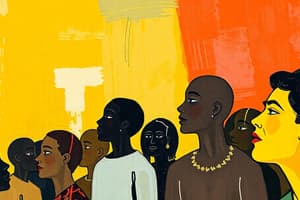Podcast
Questions and Answers
What is the primary difference between racism and xenophobia?
What is the primary difference between racism and xenophobia?
- Racism is directed towards people of a specific race, while xenophobia is directed towards people of a specific nationality.
- Racism is directed towards people of a specific culture, while xenophobia is directed towards people of a specific ethnicity.
- Racism is always institutional, while xenophobia is always interpersonal.
- Racism is a belief in the superiority of one's race, while xenophobia is a fear of people from other countries. (correct)
What is the primary goal of combating racism and xenophobia through education and awareness?
What is the primary goal of combating racism and xenophobia through education and awareness?
- To promote media literacy and critical thinking to combat stereotypes and misconceptions. (correct)
- To promote a culture of assimilation and cultural homogenization.
- To provide a platform for marginalized groups to express their grievances.
- To create a sense of guilt and shame among individuals who engage in discriminatory behaviors.
What is the term used to describe the negative messages and stereotypes internalized by individuals from a marginalized group?
What is the term used to describe the negative messages and stereotypes internalized by individuals from a marginalized group?
- Institutional racism
- Internalized racism (correct)
- Systemic racism
- Interpersonal racism
Which of the following historical systems of exploitation is an example of institutional racism?
Which of the following historical systems of exploitation is an example of institutional racism?
What is the primary consequence of racism and xenophobia on the health and well-being of individuals?
What is the primary consequence of racism and xenophobia on the health and well-being of individuals?
What is the term used to describe the prejudice and discrimination that occurs between individuals of different racial groups?
What is the term used to describe the prejudice and discrimination that occurs between individuals of different racial groups?
What is the primary goal of policy and legislation in combating racism and xenophobia?
What is the primary goal of policy and legislation in combating racism and xenophobia?
What is the term used to describe the trauma that is passed down through generations, affecting the mental and emotional well-being of individuals?
What is the term used to describe the trauma that is passed down through generations, affecting the mental and emotional well-being of individuals?
Flashcards are hidden until you start studying
Study Notes
Definition and Types of Racism
- Racism: the belief that a particular race is superior to others, often leading to discrimination, prejudice, and inequality
- Institutional racism: discriminatory practices and policies embedded in institutions and systems
- Internalized racism: when individuals from a marginalized group internalize negative messages and stereotypes about their own group
- Interpersonal racism: prejudice and discrimination between individuals of different racial groups
Xenophobia
- Fear or dislike of people from other countries or cultures
- Often linked to racism, but can also be directed towards people of different nationalities, ethnicities, or religions
- Can manifest as discrimination, violence, or exclusion
Historical and Contemporary Examples
- Slavery and colonialism: historical systems of exploitation and oppression based on race and ethnicity
- Apartheid: a system of institutionalized racism in South Africa (1948-1994)
- Racial segregation in the United States (1865-1964)
- Contemporary examples:
- Police brutality and racial profiling in the United States
- Islamophobia and anti-immigrant sentiment in Europe
- Discrimination against indigenous peoples and minorities in various countries
Effects of Racism and Xenophobia
- Health disparities: racism and xenophobia can lead to poor mental and physical health outcomes
- Education and economic inequality: discrimination can limit access to education and job opportunities
- Social and political marginalization: racism and xenophobia can lead to exclusion from political and social processes
- Intergenerational trauma: historical trauma can be passed down through generations, affecting mental and emotional well-being
Combating Racism and Xenophobia
- Education and awareness: promoting critical thinking and media literacy to combat stereotypes and misconceptions
- Policy and legislation: implementing laws and policies to prevent discrimination and promote equality
- Community engagement and activism: mobilizing communities to address racism and xenophobia
- Empathy and allyship: building bridges between different groups and promoting understanding and support
Types of Racism
- Racism: belief in racial superiority, leading to discrimination, prejudice, and inequality
- Institutional racism: discriminatory practices and policies embedded in institutions and systems
- Internalized racism: marginalized groups internalizing negative messages and stereotypes about their own group
- Interpersonal racism: prejudice and discrimination between individuals of different racial groups
Xenophobia
- Fear or dislike of people from other countries or cultures, often linked to racism
- Can manifest as discrimination, violence, or exclusion directed towards people of different nationalities, ethnicities, or religions
Historical and Contemporary Examples
- Slavery and colonialism: historical systems of exploitation and oppression based on race and ethnicity
- Apartheid: institutionalized racism in South Africa (1948-1994)
- Racial segregation in the United States (1865-1964)
- Contemporary examples:
- Police brutality and racial profiling in the United States
- Islamophobia and anti-immigrant sentiment in Europe
- Discrimination against indigenous peoples and minorities
Consequences of Racism and Xenophobia
- Health disparities: racism and xenophobia can lead to poor mental and physical health outcomes
- Education and economic inequality: discrimination limits access to education and job opportunities
- Social and political marginalization: racism and xenophobia lead to exclusion from political and social processes
- Intergenerational trauma: historical trauma affects mental and emotional well-being across generations
Combating Racism and Xenophobia
- Education and awareness: promoting critical thinking and media literacy to combat stereotypes and misconceptions
- Policy and legislation: implementing laws and policies to prevent discrimination and promote equality
- Community engagement and activism: mobilizing communities to address racism and xenophobia
- Empathy and allyship: building bridges between different groups and promoting understanding and support
Studying That Suits You
Use AI to generate personalized quizzes and flashcards to suit your learning preferences.





